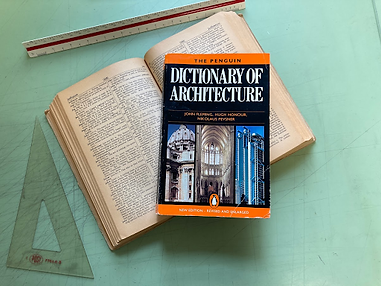

The Architecture profession has been around for centuries and as such many of the technical terms and jargon that architects use in their day to day life. Overtime, however, language has evolved and these same words we use every day came to mean different things to different people. As Teitsch Kent Fay Architects, P.C. brought on more and more co workers of the younger generation, this language barrier became more and more apparent.
To an architect, trained in the 1980's, calling something sketchy is a good thing. This typically refers to a rough, simple drawing, which may be incomplete or somewhat undefined. Despite this it captures the basic idea, or essence that is intended. To our younger colleagues, sketchy is a negative description of something that is suspicious or untrustworthy. Asking a younger person to prepare a “sketchy presentation” will probably not result in what the older person was expecting.


To our younger friends, as well as to the general public, ha-ha is just an expression of amusement or a favorite catch phrase of Nelson from the Simpsons. To design professionals, particularly landscape designers, a ha-ha is a type of sunken fence that was commonly used in landscaped gardens and parks in the 18th century. The point of a ha-ha was to give the viewer of the garden the illusion of an unbroken, continuous rolling lawn, whilst providing boundaries. While this version of a ha-ha is important to having a beautiful yard, it isn’t particularly funny.
More of a professional convention than a word or phrase, architectural delineation has for many years used lettering to provide notations on our drawings. This lettering, originally drawn by hand and now generated electronically, has conventionally been written with only capitalized letters. This allowed the words to be more simply formed, and given that it might be written by a number of different drafters, hopefully more uniform and easier to read. To our younger friends, who have lived their entire lives with email and texting, the use of capital letters is often interpreted as SHOUTING, or YELLING, and can be considered quite rude. So, next time you are reading an architect’s drawings, don’t be afraid that your architect is angry. They are only trying to make sure that their work can be understood.


This confusion goes both ways, as we older designers often use peculiar words that are not well understood by our successors. One example of this is “fenestration” a Latin word that means windows and doors, or openings in the facade of a building. Older architects use this term quite frequently, while younger people, and other non architects might say: “Why can’t you just say windows and doors!”
Language is a wonderful, and occasionally frustrating thing. While our profession is full of jargon and technical terms, the most important thing for us is to work cohesively with everyone involved to ensure the project is effectively completed and all parties, old and young, are understood. We have learned over the years that just talking through confusion with team members is one of the easiest ways to avoid these confusions. We hope to continue to use these practices as our team grows and hope that you will use them as well.





